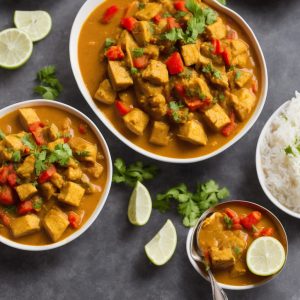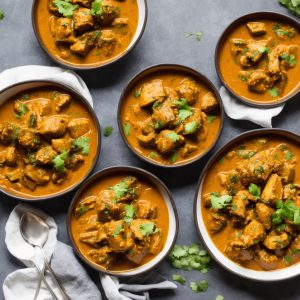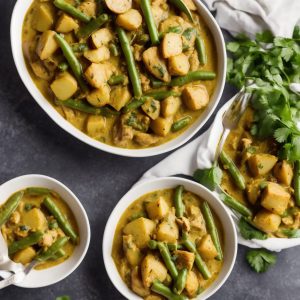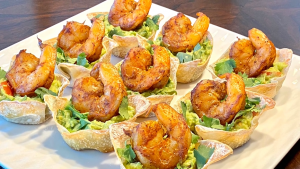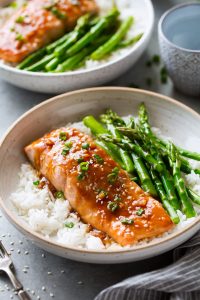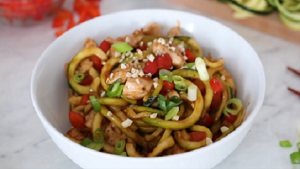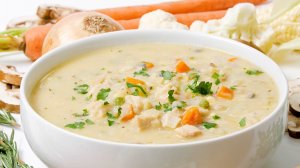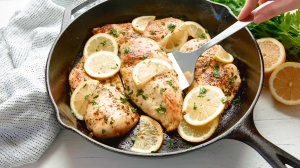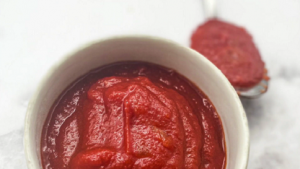This homemade chicken curry recipe combines the richness of coconut milk with the vibrant flavors of thai red curry paste and yellow curry powder. It's a comforting dish that's perfect for a cozy night in and is sure to impress your family and friends.
If you're heading to the supermarket, keep an eye out for thai red curry paste and fish sauce, which might not be commonly found in every pantry. Both of these ingredients add a unique depth of flavor to the curry. Fresh cilantro is also essential for garnishing the dish.
Ingredients For Homemade Chicken Curry
Chicken breast: The main protein in this dish, providing a tender and juicy texture.
Vegetable oil: Used for sautéing the onions and garlic, helping to develop the base flavors.
Garlic: Adds a fragrant and savory element to the curry.
Yellow onion: Provides a sweet and mild flavor, creating a flavorful base for the curry.
Yellow curry powder: A spice blend that adds a warm and earthy flavor to the dish.
Thai red curry paste: Adds a spicy and aromatic kick to the curry.
Coconut milk: Creates a rich and creamy sauce, balancing the spices.
Water: Used to adjust the consistency of the sauce as needed.
Brown sugar: Adds a touch of sweetness to balance the savory and spicy elements.
Fish sauce: Provides a salty and umami flavor, enhancing the overall taste of the dish.
Lime juice: Adds a bright and tangy note, cutting through the richness of the coconut milk.
Salt: Enhances the flavors of all the ingredients.
Fresh cilantro: A fresh and herbaceous garnish that adds color and flavor.
White rice: Serves as the perfect base for soaking up the delicious curry sauce.
One reader, Aurora Austin says:





This homemade chicken curry recipe is fantastic! The flavors are rich and perfectly balanced, with just the right amount of spice. The coconut milk adds a creamy texture that complements the tender chicken beautifully. It's a delightful dish that's easy to make and sure to impress. Highly recommend!
Techniques Required for Making Homemade Chicken Curry
How to mince garlic: Mince garlic by peeling the cloves and finely chopping them with a knife until they are in small, even pieces. How to dice an onion: Dice an onion by cutting it in half, peeling off the skin, and then making horizontal and vertical cuts to create small, even pieces. How to brown chicken: Brown chicken by cooking it in a hot pan with oil until the surface turns golden brown, which helps to seal in the juices. How to simmer: Simmer by cooking the ingredients at a low, steady temperature just below boiling, allowing flavors to meld and the sauce to thicken. How to cook rice: Cook rice by rinsing it under cold water, then boiling it in a pot with water until tender, or using a rice cooker for convenience.
How To Make Homemade Chicken Curry
Skip the takeout and whip up your own filling chicken curry, made with tender chicken and veggies, all simmered in a creamy coconut soup served over rice!
Serves:
Ingredients
- 1lbchicken breast,boneless, skinless, chopped into bite-sized pieces
- 1tbspvegetable oil
- 1tbspgarlic,minced
- 1small yellow onion,or white, chopped
- 2tbspyellow curry powder
- 1tbspThai red curry paste
- 15ozcoconut milk,canned, full fat
- ½cupwater,or chicken stock, optional
- 1tbspbrown sugar
- 1tspfish sauce
- 2tbsplime juice
- salt,to taste
- fresh cilantro,a handful, roughly chopped
- 4cupswhite rice,cooked, to serve
Instructions
-
Heat the oil in a large pot over medium-low heat. Add the onions and minced garlic, and cook for a few minutes until the onions are fragrant and softened.
-
Add the chicken and cook for 2 to 3 minutes, browning it a little. Add the curry powder and paste, and cook for 3 to 5 minutes.
-
Add the coconut milk, and let simmer for 15 to 20 minutes or until the chicken is fully cooked.
-
Add the water or chicken stock depending on the consistency desired for the sauce, or let simmer longer to thicken, if needed.
-
Stir in the brown sugar, fish sauce, and lime juice. Taste and add salt, if needed
-
Top with fresh cilantro. Serve over cooked rice, and enjoy!
Recipe Notes
Nutrition
- Calories: 1174.78kcal
- Fat: 38.52g
- Saturated Fat: 23.75g
- Trans Fat: 0.15g
- Monounsaturated Fat: 8.57g
- Polyunsaturated Fat: 3.55g
- Carbohydrates: 165.59g
- Fiber: 2.36g
- Sugar: 3.33g
- Protein: 39.88g
- Cholesterol: 72.94mg
- Sodium: 1141.66mg
- Calcium: 85.54mg
- Potassium: 780.54mg
- Iron: 6.89mg
- Vitamin A: 47.16µg
- Vitamin C: 7.22mg
Crucial Technique Tip for Homemade Chicken Curry
To enhance the flavor of your chicken curry, toast the curry powder in the oil for a minute before adding the chicken. This will release the essential oils and deepen the spice's aroma, giving your dish a richer taste.
Time-Saving Tips for Preparing Chicken Curry
Prep ingredients ahead: Chop the onions, mince the garlic, and cut the chicken breast in advance to streamline the cooking process.
Use pre-cooked rice: Save time by using pre-cooked white rice or microwaveable rice packets.
One-pot cooking: Minimize cleanup by cooking everything in a single large pot.
Simmer efficiently: Use a lid to cover the pot while simmering to speed up the cooking time.
Measure spices in advance: Pre-measure the curry powder, red curry paste, and other spices to add them quickly when needed.
Substitute Ingredients For Homemade Chicken Curry Recipe
chicken breast - Substitute with tofu: Tofu is a great vegetarian alternative that absorbs the flavors of the curry well.
vegetable oil - Substitute with coconut oil: Coconut oil adds a subtle coconut flavor that complements the curry.
garlic - Substitute with garlic powder: Garlic powder can be used if fresh garlic is unavailable, though the flavor may be slightly less intense.
yellow onion - Substitute with red onion: Red onions can be used in place of yellow onions and will add a slightly different, but still delicious, flavor.
yellow curry powder - Substitute with garam masala: Garam masala provides a different spice profile but can still create a flavorful curry.
thai red curry paste - Substitute with sriracha: Sriracha can add heat and a bit of tanginess, though it lacks the depth of flavor found in curry paste.
coconut milk - Substitute with almond milk: Almond milk can be used for a lighter, less creamy curry, though it won't have the same richness.
water - Substitute with chicken broth: Chicken broth adds more depth of flavor compared to plain water.
brown sugar - Substitute with honey: Honey can provide sweetness, though it will add a slightly different flavor profile.
fish sauce - Substitute with soy sauce: Soy sauce can provide the umami flavor, though it lacks the distinct fishy taste.
lime juice - Substitute with lemon juice: Lemon juice can provide the necessary acidity, though it has a slightly different flavor.
salt - Substitute with soy sauce: Soy sauce can add both saltiness and umami flavor.
fresh cilantro - Substitute with parsley: Parsley can be used as a garnish, though it lacks the distinct flavor of cilantro.
white rice - Substitute with brown rice: Brown rice is a healthier alternative that adds a nutty flavor and more fiber.
Presenting Your Homemade Chicken Curry
Serve smaller portion sizes: Present the chicken curry in a shallow, wide-rimmed bowl to showcase the vibrant colors and textures. Use a ring mold to shape the white rice into a neat, compact mound beside the curry.
Use decoration: Garnish with finely chopped fresh cilantro and a few thin slices of lime on the side for a pop of color and freshness. Add a small drizzle of coconut milk on top for a refined touch.
Highlight textures: Ensure the chicken pieces are evenly browned and the onions are caramelized to add depth to the dish. The curry sauce should be smooth and glossy, indicating a well-emulsified mixture.
Balance flavors: Taste the curry before serving to ensure the brown sugar, fish sauce, and lime juice are perfectly balanced, creating a harmonious blend of sweet, salty, and tangy notes.
Use high-quality ingredients: Opt for organic chicken breast and fresh yellow onion to enhance the overall flavor and quality of the dish. Use premium curry powder and thai red curry paste for an authentic taste.
Presentation utensils: Serve the chicken curry with a small, elegant ladle and the white rice with a decorative spoon to elevate the dining experience.
Essential Tools for Making Chicken Curry
Large pot: Used for cooking the curry, ensuring even heat distribution and enough space for all ingredients.
Wooden spoon: Ideal for stirring the ingredients without scratching the pot.
Chef's knife: Essential for chopping the chicken, onions, and mincing the garlic.
Cutting board: Provides a safe and clean surface for cutting the chicken and vegetables.
Measuring spoons: Ensures precise measurement of ingredients like oil, curry powder, curry paste, brown sugar, fish sauce, and lime juice.
Measuring cup: Used for measuring the coconut milk and water accurately.
Rice cooker: Convenient for cooking the white rice to serve with the curry.
Serving spoon: Useful for serving the curry over the cooked rice.
Ladle: Helps in serving the curry, especially if the consistency is more liquid.
Tongs: Handy for turning the chicken pieces while browning them in the pot.
Small bowl: Useful for mixing the lime juice, fish sauce, and brown sugar before adding to the curry.
Grater: If you prefer freshly grated garlic, this tool will be useful.
Spatula: Helps in scraping down the sides of the pot to ensure all ingredients are well mixed.
Storing and Freezing Your Homemade Chicken Curry
- Let the chicken curry cool completely before storing or freezing.
- Transfer the cooled curry to an airtight container or a freezer-safe bag.
- If using a container, make sure to leave some space at the top for expansion during freezing.
- Label the container or bag with the date and contents for easy identification.
- Store the chicken curry in the refrigerator for up to 3-4 days.
- To freeze, place the airtight container or freezer-safe bag in the freezer for up to 2-3 months.
- When ready to eat, thaw the frozen chicken curry in the refrigerator overnight.
- Reheat the thawed or refrigerated curry in a pot over medium heat, stirring occasionally, until it reaches the desired temperature.
- If the curry appears too thick after reheating, add a little water or coconut milk to adjust the consistency.
- Serve the reheated chicken curry over freshly cooked rice and garnish with fresh cilantro, if desired.
How To Reheat Leftover Chicken Curry
Stovetop method: transfer the leftover chicken curry to a saucepan or pot. Heat it over medium-low heat, stirring occasionally, until it reaches the desired temperature. If the curry appears too thick, add a splash of water or coconut milk to thin it out and prevent it from drying out or sticking to the bottom of the pan.
Microwave method: place the leftover chicken curry in a microwave-safe dish. Cover the dish with a microwave-safe lid or plastic wrap, leaving a small vent for steam to escape. Microwave on high power in 30-second intervals, stirring between each interval, until the curry is heated through. Be careful when removing the dish from the microwave, as it may be hot.
Oven method: preheat the oven to 350°F (175°C). Transfer the leftover chicken curry to an oven-safe dish and cover it with aluminum foil. Place the dish in the preheated oven and bake for 15-20 minutes, or until the curry is heated through. Stir the curry halfway through the reheating process to ensure even heating.
Slow cooker method: if you have a large amount of leftover chicken curry, you can reheat it in a slow cooker. Transfer the curry to the slow cooker and set it to low heat. Cover and let the curry reheat for 1-2 hours, stirring occasionally, until it reaches the desired temperature. This method is particularly useful if you want to keep the curry warm for an extended period.
Regardless of the reheating method you choose, be sure to reheat the chicken curry until it reaches an internal temperature of at least 165°F (74°C) to ensure food safety. Always taste the reheated curry and adjust the seasoning if needed, as flavors may have mellowed during storage.
Interesting Fact About Chicken Curry
A random fact about this recipe is that the combination of coconut milk and thai red curry paste creates a rich and creamy base, which is a hallmark of many traditional Thai curry dishes.
Is Making Chicken Curry at Home Cost-Effective?
This homemade chicken curry recipe is quite cost-effective for a household. The main ingredients like chicken breast, coconut milk, and white rice are relatively affordable. The use of vegetable oil, garlic, yellow onion, and cilantro adds flavor without breaking the bank. The spices and thai red curry paste might be a bit pricier but are used in small quantities. Overall, this dish rates an 8 out of 10 for cost-effectiveness. The approximate cost for a household of 4 people is around $15-$20 USD.
Is Chicken Curry Healthy or Unhealthy?
This homemade chicken curry recipe has both healthy and unhealthy aspects. Let's break it down:
Healthy elements:
- Chicken breast is a lean protein source
- Garlic and onions offer beneficial compounds and flavor without added calories
- Coconut milk provides healthy fats, but it is high in calories and saturated fat
- Brown sugar is a more natural sweetener than refined white sugar
- Lime juice adds vitamin C and brightens the dish
- Cilantro is a fresh herb packed with antioxidants
Unhealthy elements:
- Vegetable oil is a refined oil high in omega-6 fatty acids
- Thai red curry paste may contain added sugars and preservatives
- Fish sauce is high in sodium
- White rice is a refined grain lacking fiber and nutrients compared to brown rice
To make this dish healthier, consider these suggestions:
- Replace vegetable oil with coconut oil or olive oil
- Use light coconut milk to reduce calories and saturated fat
- Opt for a homemade or clean-label curry paste to avoid added sugars and preservatives
- Reduce the amount of fish sauce and replace some with low-sodium soy sauce or salt
- Serve with brown rice, quinoa, or cauliflower rice for added fiber and nutrients
- Increase the vegetable content by adding bell peppers, carrots, or spinach for extra vitamins and minerals
- Garnish with additional fresh herbs like Thai basil or mint for more flavor and antioxidants
By making these adjustments, you can enhance the nutritional value of this delicious chicken curry while still enjoying its comforting flavors. The key is to strike a balance between taste and health, using whole food ingredients and being mindful of portion sizes.
Editor's Opinion on This Chicken Curry Recipe
This homemade chicken curry recipe is a delightful fusion of flavors, combining the warmth of yellow curry powder with the boldness of Thai red curry paste. The coconut milk adds a creamy richness, while the brown sugar, fish sauce, and lime juice create a balanced sweet, salty, and tangy profile. The use of fresh cilantro as a garnish adds a refreshing touch. Serving it over white rice makes it a comforting and satisfying meal. For an extra layer of flavor, consider adding some fresh ginger or a splash of soy sauce. Overall, a well-rounded and flavorful dish.
Enhance Your Homemade Chicken Curry Recipe with These Unique Side Dishes:
Similar Recipes to Homemade Chicken Curry
Appetizer and Dessert Pairings for Homemade Chicken Curry
Why trust this Homemade Chicken Curry Recipe:
This homemade chicken curry recipe is a must-try for its perfect balance of flavors. The combination of yellow curry powder and thai red curry paste creates a rich and aromatic base, while coconut milk adds a creamy texture. The addition of brown sugar, fish sauce, and lime juice ensures a harmonious blend of sweet, salty, and tangy notes. Topped with fresh cilantro and served over fluffy white rice, this dish is both comforting and satisfying. Trust this recipe for a delightful culinary experience.
Was this page helpful?
Have your own special recipe to share? Submit Your Recipe Today!



